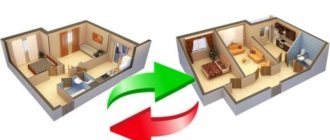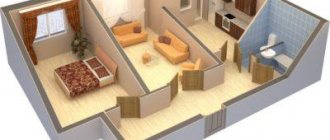General information
Privatization is the alienation of state property into the ownership of a private person.
This opportunity exists for individuals who do not have property in the Unified State Register. A similar action is possible for individual entrepreneurs and legal entities if their capital is less than 25%.
The procedure can now be completed only on a budgetary basis. Although existing entrepreneurs want to introduce a fee for such a procedure, the state does not yet allow them to do this.
The only thing you have to pay for is the issuance of title documents.
Residents' rights
Any apartment owner can obtain the right to privatize an attic. The main thing is to have the written consent of the other residents to this procedure.
After receiving the title documents, he will be able to use the squares at his discretion.
But it is worth remembering that, in accordance with current legislation, this type of real estate can only be purchased. According to the contract, the object is not transferred.
Concept
The program started working in Russia in 1991.
There were many attempts to cancel the procedure and make it paid in 2019, however, no official changes followed.
Basic principles of the transfer of real estate into private ownership.
- The right is provided free of charge, and payment may only be charged for processing documents or entering information into the Unified State Register (state fee).
- You can only receive real estate from the state once in your entire life.
- The transaction is concluded through a transfer of rights agreement, after which the owner is issued a housing certificate.
- The main tenant of state housing has the right to refuse the procedure.
- To conclude an agreement on the transfer of ownership, all registered members of the living space must give their consent.
Is it possible to buy an attic?
Often, owners of apartments on the top floors of an apartment building have a desire to improve their living conditions by planning to add an attic space. But you need to understand whether such changes are legal.
The technical floor of the building is classified as common property. The law allows it to be registered as property by one of the residents. This right is given to the owners of all MKD apartments.
But you will have to get the consent of your neighbors. It is important that the appropriation of the attic does not violate the legitimate interests of the remaining residents of the apartment building. It is prohibited to open a noisy establishment in the attic area. The appropriation of non-residential premises has many nuances and pitfalls.
This complicates the process of implementing the plan. For example, the presence of a condominium or HOA in the house is of great importance. It is also worth considering how many people manage the residential building. You must be prepared for the fact that appropriating an attic will take a lot of time, effort, and also require certain financial investments. If the attic is already owned by one of the neighbors, then you can try to buy it.
The difficulty of renting an attic is that sewer risers, ventilation shafts and chimneys usually pass through it. This room reduces heat transfer and insulates the last floor of the building.
Residents' rights to the attic
Privatization of the attic space is an option available to any home owner, with only one caveat - the remaining residents must approve the decision.
After receiving the right to the desired object, the tenant will be able to dispose of the attic at his own discretion, without any restrictions:
- reconstruct;
- live indoors;
- use as a utility room;
- rent out.
Selling an attic space, even one that is owned, is only possible together with your apartment.
Unlawful actions in the case of privatization can come both from neighbors and from a citizen who decides to add an attic space to the apartment.
- From a citizen: some apartment owners living on the top floors incorrectly believe that the right to use the attic belongs to them by default. This is a mistake - the attic is a common area of the house and all residents can use it. If a tenant living under the attic decides to bypass privatization and occupy the technical floor, he is acting outside the law.
- From neighbors: if all residents of the house have given their consent to the privatization of the attic and the transaction has been formalized, they have no right to use this premises. Entering privatized territory will be considered illegal.
All residents of the house have absolutely equal rights to all premises of the house that serve not one apartment, but at least several, be it elevators, stairwells, basements and attics.
Only the owners of the upper or lower floors, respectively, can register ownership of an attic or basement.
They do not have the exclusive right to these premises, but with the consent of the other residents they can reconstruct and register ownership.
Is it possible to privatize the attic above your apartment?
Theoretically, yes, it is possible. The attic, like staircases, as well as other common areas of an apartment building are the shared property of all residents. Thus, formally, part of the attic already belongs to the owner of the apartment (Article 36 of the Housing Code of the Russian Federation). However, in practice it will be quite difficult to exercise this right. Moreover, an attempt to arbitrarily “seize” this premises is a serious violation, so doing so is categorically not recommended.
Main problems
The first problem associated with registering an attic as personal property is the reluctance of other residents. Few people would agree for their neighbor to simply take part of the common space for himself, even if no one is going to use it anyway. Therefore, the first thing you need to do is try to negotiate with other residents. This can be done at a general meeting.
You can offer a certain amount of compensation to all other residents or some additional services/work at your own expense. A popular solution is to create a playground, a recreation area, a beautiful flower bed, and so on in the local area.
The second problem is the presence of house communications in the attic. If they exist, then most often it will not be possible to use the premises for personal purposes, because the law requires constant access for maintenance personnel to communicate. In some cases, such elements can be moved to another location, but this happens quite rarely and most often nothing can be changed.
Example : If electrical cables run above the apartment, in theory they can be moved or reconnected by moving them to the side. But it is virtually impossible to do anything with the pipes or, especially, the elevator shaft.
There are other problems that may make it impossible to privatize an attic:
- Major renovation . If a major renovation is planned in the house in the near future, no one will give the attic to the ownership of one person. On the other hand, after renovation, such a room will become much more attractive, and therefore it makes sense to wait.
- House demolition . If the house is declared unsafe and it is planned to demolish it, then the attic could be an excellent addition to the apartment, because compensation from the state directly depends on the value of the lost property. And it is for this reason that all authorities whose permission is required to obtain ownership of this premises will be categorically against it.
- Private property . It also happens that the attic is already registered as the property of another person. On the one hand, this excludes the possibility of privatization, on the other, it opens up the possibility of purchasing a separate part of this very attic, because it is unlikely that this room will be used in its entirety.
In some cases, it will not be possible to obtain ownership of the attic under any circumstances. And then it makes sense to consider the possibility of drawing up a lease agreement.
Institutions for privatization of the attic above the apartment
Depending on what exactly you plan to do with this premises, as well as on the current situation, in order to privatize the attic you will first have to visit a number of authorities:
- Bureau of Architecture . If you plan to reconstruct the attic. Also, this organization can, in principle, assess how feasible it is for a private individual to use this premises.
- Rospotrebnadzor , Gas and Fire Inspections. The attic is checked to ensure it meets all necessary standards.
- Housing inspection . You should contact this if you plan to use the attic as a living space.
Only after all the certificates from these organizations have been received can you proceed directly with the registration of ownership.
Common premises in residential buildings do not need to be privatized, but they need to be registered as private property (if you plan to use them). Such premises are automatically the property of all residents of the house. The exception is situations with old houses. In this case, you first need to privatize the common premises and the local area and only then deal with the registration of ownership of the attic.
Registration of rights to attic space
We provide legal services for registration of rights to convert attic spaces into attic-type residential premises through reconstruction work/conversion of the attic space.
Our specialists order and receive from a specialized (design) organization a technical report on the possibility of converting (reconstructing) the attic space into a residential or other type of attic floor, on the condition of the house structures, top floor ceilings and roof structures.
The owner of the apartment on the top floor of the house can connect the attic to the apartment.
What options are there?
You can use the attic only if you rent or privatize the premises . Since rent represents the temporary nature of ownership and use of real estate, we will not consider this option. But if you want not only to use, but also to own and dispose of the attic, then we can only talk about privatization.
You have two options on how to privatize the attic above your apartment - the first case is to negotiate with the management company .
If the attic does not have any communications and is not in disrepair, the management company, which during the development reserved the right to use the residential premises, may allow you to carry out the privatization procedure.
But often, the management company does not have the right to dispose of such real estate, since the shared construction agreement, and even the charter of the management company, states that the residents have equal rights to the ownerless real estate of the house.
Remember! Before you begin your privatization actions, you must obtain the agreement of everyone inhabiting this building.
We invite you to familiarize yourself with information about where to start privatization, what the cost is, where to go for registration and in what case a citizen may be denied privatization.
Step-by-step instruction
So, in order for you to become the rightful owner of the attic space, you need:
- Conduct a house-wide meeting of residents;
- Ask them to vote;
- If you receive one hundred percent of the votes to engage in privatization, you can begin collecting documents;
- You must provide the documents both to the management company for review, and to the city administration, namely to the privatization committee;
- Wait for the result of the review;
- If the answer is positive, privatize the property in Rosreestr.
Do not forget! Before you begin the complex procedure of collecting documents, make sure that this living space is not actually occupied by anyone, otherwise all your efforts will be in vain.
Collection of documents
Documents can be divided into two large groups. First of all, to privatize an attic space you will need documents from various authorities, but we will talk about them later and in a separate topic. You will also need papers for the apartment , which you already have on hand. These include the following papers:
- Cadastral plan of your apartment;
- Technical plan of your living space;
- Title documents, which include: a certificate of ownership in your name or the name of one of your household members;
- deed of gift;
- documents confirming the right to inherit this residential premises.
Obtaining neighbors' consent
Obtaining consent from neighbors is the most important point in the matter of privatization .
After all, according to all the rules, the attic is a common house property , if no one managed to privatize it much earlier.
Conduct a vote by inviting all residents to a meeting, or independently go around all the apartments in the building and collect signatures.
If all 100% of those living in the house voted that they are not against you taking up privatization, feel free to start collecting documents, but if some abstained, did not vote, or even thought that you were neglecting the rights of other residents, you cannot apply to the attic space.
Appeal to authorities
In addition to the documents that, one way or another, you already have in your hands, you need to visit a number of authorities and collect documents required for privatization.
- So, you need to go to Rospotrebnadzor and get a certificate stating that this premises and its use will not pose a danger to the residents of the house.
- The next point of your visit is the Main Directorate of the Ministry of Emergency Situations . There they must check or simply issue a certificate stating that this structure is safe in technical terms.
- The architectural department must approve your plan for connecting the attic to the apartment or simply joining it into a single property.
- The gas inspectorate must also issue permission for connection and confirm that in this way the most important communications will be open to access.
- Contact an architect , who should draw up a project for your new home with the condition of adding an attic.
These documents are submitted to the housing committee , where in the end you should receive a final conclusion, which will determine whether privatization is possible or not.
If possible, you contact the city administration and there you carry out the final stages of this action in the form of obtaining documents and registration in Rosreestr .
How to register ownership?
Often, citizens are faced with a situation where they are denied assignment of attic space by authorized bodies. Sometimes this is due to the fact that not all documents have been collected.
But most often this part of the building is not suitable for use by its residents. Before you begin registering the attic as your personal property, you need to find out whether it is the intersection of gas pipes or water supply systems or electrical wiring.
You also need to find out if one of the residents of the apartment building already owns it. It is important that the premises are in perfect condition. Therefore, it needs to be examined carefully. If there are no restrictions, then you can proceed to registering rights to the attic. To do this, you need to decide where to apply and what documents to prepare.
Where to contact?
To register an attic as personal property, a citizen will have to visit any authority. First, you will need to contact the HOA or management company to hold a meeting of residents. If you wish, you can organize this event in person.
You will also need to contact the following organizations:
- housing committee of the city administration . Here you can find out which services need to be coordinated with for the refurbishment of the premises. The same authority checks the project’s compliance with architectural standards and issues permission for reconstruction;
- gas service, fire supervision . The reconstruction of the premises is coordinated with these institutions;
- design and architectural firm . Assists in preparing attic reconfiguration plans. The company must have the appropriate license;
- BTI . This institution makes changes to technical documentation;
- Rosreestr, Multifunctional center . Here the registration of ownership of the attic space is carried out. Here you can also get an extract from the Unified State Register for an apartment when creating a set of documents.
List of required documents
To assign an attic space to personal property, it is necessary, first of all, to obtain the consent of all residents of the apartment building.
For this purpose, a general house meeting is organized. A special act is drawn up. Each neighbor must express his opinion and put his personal signature. Residents' consent alone will not be enough to carry out the privatization procedure. A number of other documents are also required to be prepared. The set of papers can be divided into two parts: for an apartment and for a non-residential property.
The list of documents for the attic space includes the following:
- technical information about the non-residential part of the facility;
- a certificate stating that the attic is not owned or leased by someone else;
- a certificate from the BTI on the study of the premises and its suitability;
- official permission from the authorized bodies to carry out reconstruction of the attic.
Documents for an apartment include the following:
- cadastral plan;
- extract from the Unified State Register of Real Estate>;
- technical plan of the apartment above which the attic is located;
- legal documents for housing (sale and purchase agreement, deed of gift, will, etc.).
Privatization procedure and cost
When planning to register an attic as private property, you need to know how to act correctly. Then the procedure will go faster and serious problems will not arise in the future.
The procedure for privatizing an attic space is presented in the following stages:
- check with the HOA or housing cooperative for information regarding major home repairs;
- order an attic inspection. This will make it possible to find out whether it will be possible to register it as personal property;
- take an extract from the Unified State Register of Real Estate from the MFC or Rosreestr;
- hold a house-wide meeting and obtain the consent of residents to appropriate the attic;
- order an attic reconstruction project from a specialized company;
- contact the housing committee. Take a list of services from which you need to obtain consent;
- visit all the necessary departments provided by the housing committee;
- obtain consent for reconstruction from the housing committee;
- reconstruct the attic;
- submit an application to the BTI to make the necessary changes to the technical documentation;
- collect a package of documents and go with it to the MFC or Rosreestr to register ownership of the attic space. You will have to pay a state fee;
- receive an extract from the Unified State Register of Real Estate.
It is difficult to say how much privatization will cost. When resolving the issue on their own, citizens usually spend from 30,000 to 80,000 rubles. When contacting a private specialized company, costs increase by 2-4 times. Sometimes you have to pay more than 150,000 rubles.
The procedure for decorating the attic
- The first thing you need to do for this is to find out the facts of contraindications in arranging these areas of the house.
That is, the house should not be subject to reconstruction, the attic should be an attic, and not an adapted floor. No communications should be laid directly above the apartment, and demolition of load-bearing beams and main walls is prohibited. In addition to these nuances, there are certain restrictions, that is, for example, it is necessary that the roof slope is 35-55 degrees, and the load-bearing capacity of the ceiling is 150 kgf/sq.m. The first step must be confirmed by a formal expert opinion;
The second thing the future owner of the attic must do is: make sure that the house is not registered as joint ownership. Otherwise, it will be impossible to register the attic as personal property, because in this case the common areas of the house belong to the owners and cannot be seized. It is possible that the attic already belongs to third parties. Then you will need to negotiate with them. Although more often such areas of the house as the elevator area, staircases, attics and basements are the common property of all residents. Everyone will need to obtain consent. And this usually doesn’t go entirely smoothly, because there will always be at least one who will be against it. In order to achieve one hundred percent agreement, they usually hold a meeting with the participation of the HOA, convince them of the undoubted benefits of reconstructing the premises, and promise in return high-quality repairs or a children’s playground;
- If the first two circumstances do not interfere with the desire to appropriate the attic, then you can begin to collect the necessary package of documents. First, you will need a package of permits, that is, those that will make it possible to obtain permission to convert the attic space from the organization that has this house on its balance sheet.
After sending the request, the owner will receive two responses:- On the presence/absence of the technical possibility of re-equipping the premises;
With the first positive: burdened work that can be completed. This, of course, is not necessary, but usually investors fulfill this point: they repair the facade, build playgrounds.
- In the case of arranging an attic for non-residential premises, permission from two more organizations will be required. This is the department of Civil Defense and the Ministry of Emergency Situations, which checks the presence of this house on its lists. This is also the Property Department, which finds out whether there are any encumbrances on the premises, in other words, whether it is rented out or even sold to anyone;
- Only after receiving the go-ahead from these departments can you begin collecting the remaining documents. This is BTI documentation in six positions:
- Technical passport for the house, or rather, an extract from it;
- House plan with explication of the apartment directly under the attic;
- Plan of the attic itself.
Certificate confirming the condition of the premises;
It should be said that a certificate from the BTI requires its employees to travel directly to the site to take measurements, so you need to order it in advance, about one month in advance.
Documentation confirming the right to ownership of the apartment located under the attic:
- House book entries with copies of financial personal accounts. Usually these documents are necessary if the attic is larger in area than the apartment and, as a result, occupies the boundaries of another apartment. If such a fact occurs, you need to obtain the consent of the owners of the apartment above which the attic occupies. The consent must be certified by a notary. If the boundaries of the attic and the apartment completely coincide, consent is not required;
- Documents from architectural structures containing an assessment of the condition of the premises to be refurbished.
- In addition, a plan for the conversion of the attic must be drawn up, including a plan of all levels, rafters, facade. All sketches in two versions: before and after the conversion. The project will pass all the necessary authorities: from fire supervision to Rospotrebnadzor. The documentation is checked by an assessment commission, as a result which sets the price that the future owner must pay to the city budget for obtaining the rights to renovate the attic. It is impossible to indicate the exact cost, since various unforeseen expenses are possible, and the price also depends on the area and other circumstances. To make it easier, you can resort to the services of real estate companies. Intermediaries charge, according to various sources, from $500 per sq.m. for their services;
- The next stage of work is the implementation of the agreement. 9 months are allocated for all this. During this time, you need to conclude an agreement with the organization on whose balance sheet the house is maintained, so that during the work strict supervision is carried out in connection with ensuring the safety of the residents of the house. Next, it will be necessary to make design calculations: for heating, sewerage and others engineering work. They also undergo examination in the above authorities, and only then the investor receives the right to work. Upon completion of the work, a report on the work done is drawn up. The act is proof that there are no claims as a result of the reconstruction;
- Now contractual relations are drawn up and the owner’s ownership of the attic space is confirmed. He immediately receives a cadastral passport for the premises being reconstructed. And only now property rights are registered. And so, before making an entry in the Unified State Register, the right does not arise.
Privatization of the attic
Before going to the relevant authorities to privatize the attic, it is necessary to take into account possible obstacles in advance and prepare options for eliminating them. For these purposes, it is best to seek professional legal advice; this is the only way to avoid unnecessary financial expenses, as well as save your nerves and personal time.
Mentions in the law
There have been no significant changes in the legislation regarding the rental and privatization of residential and non-residential premises in 2020.
Thus, based on Article 36, all owners of an apartment building have equal rights to dispose of the following square meters of the building:
- premises that do not belong to apartments (landing, elevator, stairs, basement, attic, corridors, etc.);
- technical floors;
- the land plot on which the house is built, as well as landscaping and landscaping areas.
From the above, it should be noted that in order to assign the total area of a multi-storey building in which several apartment owners live, it is necessary to obtain the written consent of each of them.
The decision regarding reducing the square footage of common property is made at a special meeting of owners.
You can resort to privatization of any non-residential premises in an apartment building only with the consent of the neighbors and only if this does not further violate their legitimate interests, for example, in the case of a radical redevelopment or the opening of a noisy establishment in the attic area.
Privatization of the attic above the apartment without holding a meeting of the owners and obtaining their permission will be illegal, and for such actions you will have to bear administrative responsibility, implying payment of a fine in the amount established by the law of the Russian Federation
When it's possible
The assignment of attic space is possible only for those residents of an apartment building whose apartment is on the top floor. Also, only apartment owners can apply for this non-residential area.
In addition, you can privatize the attic only if:
- it is no longer part of someone's property;
- its premises are not a place where communication connections intersect (electrical wiring, water or gas pipes);
- the premises are in perfect condition;
- all residents and apartment owners give approval for privatization.
In the first case, when the attic is already someone's property, you can claim it only if no one uses it. However, for this it is necessary to negotiate with its owner. In this situation, there are two possible outcomes: sign a lease agreement or buy the premises from the owner.
If the attic is a place where communications accumulate, then it will not be possible to appropriate it. In this case, privatization is feasible only if the company managing the house gives the go-ahead for the transfer of communications located in the attic. However, this happens quite rarely, since most often this kind of redevelopment poses a danger to residents or is impossible.
According to the law, it is prohibited to give for use an attic space that is in disrepair. It will be possible to appropriate the premises only after major renovations have been carried out in it; this will have to be negotiated with the management company and the residents of the house.
Privatization and denationalization are similar concepts; in particular, privatization, as a paid or free transfer of state property into private property, is part of a broader concept - denationalization.
You can find out what legislative acts regulate the process of privatization of residential premises here.
Residents' rights
All residents of an apartment building who are the owners of their apartments have the right to use the common property of the building.
These include:
- adjoining land plots;
- basements and technical rooms;
- communications;
- elevators, stairs and landings;
- roofs and attics;
- storage rooms not located on the territory of the apartments, etc.
The procedure for such use is provided for by the Housing Civil Code, as well as Art. 36 part 2 of the Housing Code of the Russian Federation.
Thus, in relation to the above property, the owners have the following powers:
- temporarily use;
- dispose of;
- own.
As for the order, the rights here are limited by Article 290 of the Civil Code of the Russian Federation: none of the apartment owners can transfer their rights to own a particular non-residential area to third parties. An exception is the sale of an apartment, with which the new owner receives permission to use the common area and property of the house.
Based on the Housing Code, the transfer of rights to use non-residential premises to third parties is permitted only if it is leased. Thus, in the future, a privatized attic can be rented out to people who are not related to a specific apartment building and receive funds for it.
To appropriate attic non-residential premises, the consent of all owners alone will not be enough. The privatization process is very difficult and requires a lot of documentation.
The collection of documents can be divided into two stages: visiting all the necessary authorities and preparing documents for the apartment.
In the first case, the package of papers consists of:
- permission for attic conversion;
- act on the satisfactory condition of the technical premises;
- papers on inspection of the Ministry of Emergency Situations and the civil defense department (if the attic is equipped for non-residential premises);
- a certificate stating that the attic does not belong to anyone, that is, it does not have an owner or tenant;
- extract from the technical passport for the house;
- house plan;
- the layout of the attic itself.
As for the certificate from the BTI, to obtain it it is necessary to call an employee of the organization to your home to take measurements of the privatized technical premises. This should be done in advance, since it may take about a month for a BTI employee to arrive.
The second package of documents consists of the following papers:
- technical plan of the apartment above which there is an attic;
- cadastral plan;
- documents establishing ownership (certificate);
- deed of gift or other documents confirming the right to inherit a specific apartment;
- owner's passport and its copy.
All documentation must be submitted to the relevant authorities in two copies: copies certified by the owner and originals.
To privatize an attic, you will need at least two written consents from other owners who have the right to use this technical space. If the apartment building is municipal and there are no privatized apartments in it, then such permission is not necessary.
If several owners apply for the attic at once, then most likely you will have to organize an HOA and resort to the process of registering shared ownership of this technical premises.
If the attic space is an intersection of communications, then to obtain permission to use it you will have to contact the organization on whose balance sheet the apartment building is located.
Only after receiving approval for the reconstruction and its implementation will it be possible to continue the privatization process.
This kind of project must be coordinated with the State Construction Committee, otherwise problems may arise.
Upon completion of the complete reconstruction of the attic space, the next step will be to call the BTI employees. They will carry out an inspection and inventory, after which the corresponding registration certificate will be issued.
After collecting all the necessary permits and documents, you can go to court to recognize the rights to the property, and specifically, the attic area
To obtain consent from residents to use the attic space, a general meeting should be held.
A sample meeting is as follows:
- Set a collection date in advance by posting a notice on the entrance door or by personally notifying all owners.
- Gather your neighbors and tell them about your plans for the attic space so that they know that their legal rights will not be violated.
Description of the page: procedure for privatization of the attic above the apartment | Zhilservice Plus 2020 from professionals for people.
Residents of the top floors of an apartment building are looking for opportunities to expand their living space. One option is to privatize the attic above the apartment. An improved attic will not only add square footage in height, but will also increase the value of the living space.
The property of the house is also considered to be elevators, landings, basements, adjacent corridors... Unauthorized seizure of additional space is considered a malicious violation. If a hidden use of the attic is discovered, the offender will be required to return the attic, and in addition to this, to compensate the damage to the other apartment owners.
Is it possible to privatize the attic above the apartment? We propose to understand the issue from the legal perspective. At the same time, you can familiarize yourself with the procedure and nuances of privatization of non-residential premises in a residential building.
Apartment buildings include property that belongs to all apartment owners. Stairs, attics, elevator shafts - all this is the property of the residents (Article 36 of the Housing Code of the Russian Federation). The latter can enter into an agreement for the maintenance of facilities with the Management Company or Homeowners Association.
Why do residents need to privatize the attic above their apartment:
- Use for personal purposes - for example, creating an additional room (rest room, warehouse, dressing room).
- Increasing the value of your apartment - housing that is sold together with the attic is much more expensive than ordinary square meters.
- Commercial lease - non-residential objects in the house can be leased to individual entrepreneurs or legal entities; rent becomes an additional source of income.
- Protection from encroachments - the privatized attic above the apartment cannot be used by third parties (for example, the local administration without the consent of the residents).
Thus, privatization of the attic above your apartment is possible - this is a profitable decision to become the owner of non-residential premises. An object can be used for different purposes and benefit from it.
Only apartment owners can become the owner of an attic space. Most often, located on the top floor of an apartment building, i.e. right under the attic. Residents of municipal apartments do not have this right. Before privatizing the attic, they will have to transfer ownership of the occupied living space.
- Few apartment buildings are complete without an attic.
- Residents whose apartments are located on the top floors often express a desire to privatize the attic for personal interests: for arranging a utility block, for expanding living space and other needs.
- You can take ownership of this premises - just study the legislative norms and collect the necessary documents.
- It is worth noting right away that to privatize the attic you will have to put in a lot of effort, patience and painstaking work, because the future owner may encounter various problems along the way, for example, dissatisfied neighbors.
Concept
Price
Unfortunately, it is almost impossible to determine the cost of such an action, since it varies depending on the region. Also, different prices are set for obtaining technical documentation.
You can spend from one and a half to three thousand rubles on the design of an architectural plan, and another from twenty to forty thousand on the design of an attic space as a property through privatization.
Unfortunately, uniform tariffs and fees for collecting documents and the necessary fees have not been established anywhere.
Now you know how to register an attic as your property, and having correctly calculated the forces and actions, you can begin this procedure today.
Deadlines
The result of privatization of the attic space can be visible within 2-3 months after submitting the application. But as practice shows, registration lasts at least 4-6 months , or even longer. Most of the time is spent on obtaining technical permission, as well as on reconstructing the attic. Until the premises are brought into proper condition, the BTI will not issue updated documents.
So, we see that privatization of the attic above the apartment is a responsible and lengthy procedure. Applicants for an attic will have to hold a meeting, collect signatures from residents, obtain permission, undertake repairs, and only then register ownership of the attic (or rent the attic). At the same time, the nuances of legislation should be taken into account. It happens that the attic cannot be reconstructed due to the so-called “author’s design”, i.e. architectural design.
If you are experiencing difficulties or have little time to study the details of the transaction, contact the lawyers of our portal. Legal advice will allow you to feel confident and be prepared for various unforeseen situations. Attention!
Illegal actions
Often, apartment owners who live on the upper floors consider the attic to be their property. But this is far from true. All neighbors have the right to use the property.
If one of the tenants restricts the access of another person, then he is violating the law.
The right to privatize an apartment is determined by a valid document.
What is the procedure for privatizing a summer cottage? Information here.
How is the privatization of municipal housing processed in 2020? Details in this article.
How to renovate an attic
The desire to increase the space of their apartment by adding an attic sometimes arises among many residents of the upper floors.
Firstly, it is cheaper than purchasing a new apartment.
Secondly, it’s not a bad idea to make an opening in the ceiling, build a beautiful staircase and make your own second floor in the form of an attic.
But it's not all that simple. There are a lot of pitfalls along the way.
Reconstruction of the attic includes a number of sequential actions:
- First a project must be created.
Depending on the grandeur of the plans and the change of rafter systems, the project can be done independently or entrusted to a specialized organization;
- After the project has been agreed upon and accepted by the relevant authorities, you can begin to prepare the necessary materials and tools;
- Before starting work, you need to carefully check the rafters and, if necessary, strengthen them;
- Next comes roof insulation;
- The next step is exit equipment;
- At the end - finishing.
What actions are prohibited
It is strictly prohibited to use common premises, including the attic, for personal purposes without supporting documents. In other words, the residents of the house, having discovered the illegal privatization of the attic, have the right to go to court, since their rights to common shared property were violated.
You should also go to court in the case where municipal authorities gave the attic to an individual or legal entity or without the consent of the remaining owners.
Obtaining the consent of the other residents of the house must be legal. That is, you cannot mislead them and distort information in your favor. Naturally, signatures must be original.
Going to court
If owners notice a violation of their rights, they have the right to file a lawsuit in court.
Through the courts, you can also achieve justice when renting out real estate for business.
For example, they began to reconstruct the attic space without their knowledge or consent, as well as rent it out or use it for personal purposes: warehouse, office, housing.
All violations in relation to the attic space are described in Articles 246 of the Civil Code and 36 of the Housing Code.
If the law has actually been violated, the bailiffs have the right to stop the arbitrary act and return the attic space back to public use. Management companies that committed such a violation, as well as residents who illegally used the attic, will be punished.









